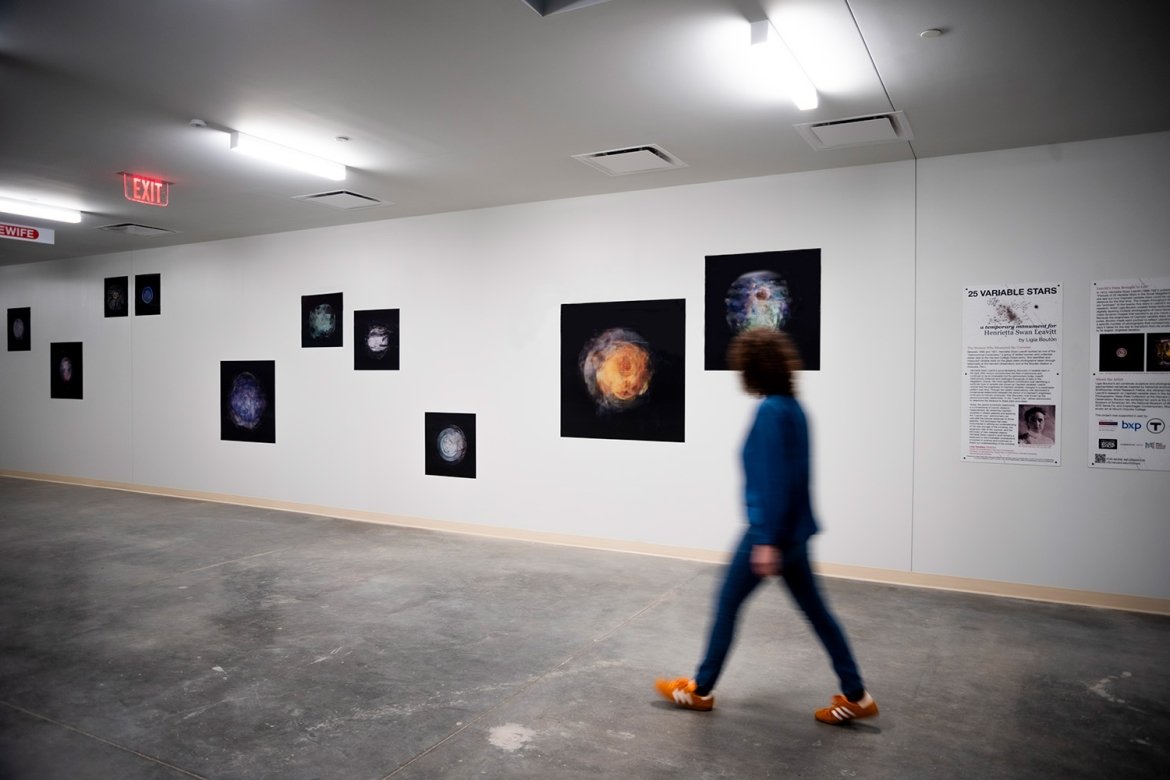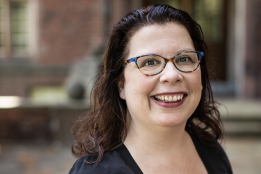Art professor installs “25 Variable Stars” for commuters

Ligia Bouton, associate professor of art studio at Mount Holyoke College, has made a Greater Boston subway stop a more pleasant place to linger with “25 Variable Stars,” her art installation celebrating astronomer Henrietta Swan Leavitt.
Greater Boston’s subway system — commonly known as the T — often gets a bad rap for delays. But thanks to sculptor Ligia Bouton, associate professor of art studio at Mount Holyoke College, Cambridge’s Kendall/MIT stop is now a more pleasant place to linger.
At last, a more scenic commute
Riders can gaze upon a galaxy of stars as they descend into the subway tunnels. This is more than just a pretty distraction. Bouton created the “25 Variable Stars” installation to honor Henrietta Swan Leavitt, one of the first American female astronomers, who worked a few miles away at the Harvard Observatory and died in relative obscurity.
From 1895 until 1921, Leavitt was part of an elite cadre of female scientists known as the Harvard Computers who collected stellar data for the observatory. Leavitt’s groundbreaking research article, “Periods of 25 Variable Stars in the Small Magellanic Cloud,” remains a classic in its field. It demonstrated that measurements of Cepheid variable stars’ brightness could be used to determine distances in the universe and laid the groundwork for astronomer Edwin Hubble’s work on scaling galactic distances.
An unheralded astronomer
Unlike Hubble, Leavitt did not become famous during her lifetime. She died of cancer in her 50s before she could win the Nobel Prize, which many of her colleagues thought she deserved. Bouton, who works at the intersection of history and art, longed to tell the astronomer’s story at a site close to the observatory.
“Leavitt really moved me because there’s very little about her out there in the world,” Bouton said. “She was a very humble person. She never married. She didn’t write a ton of letters. She didn’t keep personal journals. But her research is just staggering.”
Bouton’s work often combines art and storytelling to illuminate the past. For example, she created a series of collages based on Charlotte Brontë’s correspondence. These works were featured in the 2016 exhibition “Charlotte Great and Small,” which the Brontë Parsonage Museum in Yorkshire presented to celebrate the bicentenary of the author’s birth.
“A lot of my work has to do with historical figures, with trying to figure out ways to get at something deeper about those individuals through creative engagement with either their work or their biography,” Bouton said. “It’s about storytelling and about how we find meaning and position ourselves in the world through our histories.”
Dynamic images that tell a story
Bouton created the “25 Variable Stars” installation after receiving a 2020 Smithsonian Artist Research Fellowship. It enabled her to conduct research at the Center for Astrophysics, which is a collaboration between the Smithsonian and Harvard that is housed in the original Harvard Observatory buildings where Leavitt had toiled.
The exhibit, which features images of stars that look like they are moving, has a 92-inch-by-92-inch star as its anchor. Most of the images appear in lenticular prints Bouton made by digitally layering multiple photographs of hand-blown glass objects. The figures in the prints transform as commuters walk around them, creating the illusion of motion. The stars depicted in the installation contain eye-catching items. The number of items in each star corresponds to the number of days it takes the real star to attain maximum brightness.
“Inherent in the structure of the photograph is the data itself, which became really important to the project,” Bouton explained. “The images move in a weird way: You’ll catch a glimpse of a fish, a moose or a flower in the center. They’re there to catch your eye and give you a sense of curiosity.”
In 2023, Bouton’s installation received rave reviews when it was included in a Copenhagen exhibition called “Yet, It Moves!” which focused on artists who worked with scientists. She approached the Massachusetts Bay Transportation Authority, which operates Greater Boston’s subways, about creating the installation closer to home. To her delight, MBTA officials accepted her proposal.
“I decided it should be in Boston because that’s where Leavitt lived and where she died and where people should really know who she is. She’s a hometown hero,” the artist said.
Using art to make sense of the world
At Mount Holyoke, Bouton is something of an artistic hero herself. She serves as the chair of the Department of Art Studio, where she’s known for student mentorship. Her own artistic journey began as a refuge. Growing up with dyslexia, she found solace in art before earning a bachelor’s degree at Vassar College and a Master of Fine Arts at Rutgers University.
“Art felt like something I was really good at, a place where I felt like I could be,” she said. “It’s really helped me navigate the world in a way that’s really engaging and interesting to me. It’s opened incredible doors for me.”
Now, she strives to foster creativity in her students through the lens of liberal arts.
“I find Mount Holyoke to be a very inspiring place for artists and practitioners. Our students are taking classes in lots of different fields, and they bring those interests and those germs of knowledge into our studios. As an artist whose life has really been driven by research, it’s a really exciting place,” Bouton explained.
“When students don’t know what to make a project about, I ask: ‘What are you reading? What are you looking at? What other classes are you taking? What can we draw upon?’” she added. “I think that’s a really successful way to think about art as a part of liberal arts.”
The Leavitt installation will be on display at the subway station for about 18 months. Bouton hopes it will inspire MIT-bound travelers to put down their phones or books and to gaze at the sky — and give one lesser-known female scientist her due.
“I hope it produces a sense of wonder,” Bouton said. “It’s a little bit odd. It’s inspiring. I hope it makes people want to learn something more about her.”
